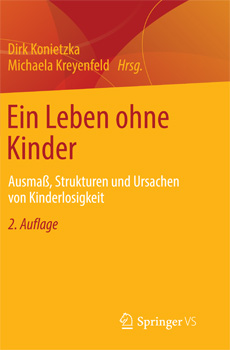September 24, 2013 | News | New Publication
Life without children
A new book on childlessness by MPIDR-researcher Michaela Kreyenfeld will be published soon. In the interview, she talks about the factual reliability of official statistics and does away with the misassumption that it is above all female academics who opt not to have children.

The book "Leben ohne Kinder" (Life without children) will probably be published October 31, 2013.
Mrs. Kreyenfeld, it is only five years ago that the first edition of your book has come on the market. Isn’t it a bit early for a new edition?
Michaela Kreyenfeld: No, definitively not. We have updated and extended the new edition because new studies have been conducted and new results have come to light. Several authors thus have substantially revised their contributions. And we want to address the issue of involuntary childlessness, a topic that has not been included in the first edition. More importantly, though, we want to make sure that the topic remains on the agenda. Shortly after the first edition was published, a legislative amendment affecting vital statistics and the micro census came into force. Meaning that new data are now available that can be used to measure childlessness.
Figures circulated in public discourse according to which around 40 percent of highly educated women remain childless.
And this is exactly where the problem lies: These figures were based in part on shaky data. In contrast to other countries, they were not based on official vital statistics. Vital statistics include all births registered at Residents’ Registration Offices. The absurd things was that — until the legislative amendment came into force — the biological order of birth, i.e. parity-specific information, was collected for births within marriage only. We need to have the biological order to measure childlessness. So you could say that we had to do without these figures for long – and these figures are, after all, extremely important to politics and science – simply because of the old-fashioned notion that it is not considered polite to quiz unmarried women about their illegitimate children. But that has changed now.
What will the new data situation look like for researcher?
Vital statistics has been reformed now, but it will take around 30 years until we can calculate childlessness from these statistics. The reason being that data for a full birth cohort have to be collected with the new method before childlessness can be calculated for this cohort.
We need to wait 30 years for these results? But we need them much earlier. After all, we need to know how strongly we will be affected by demographic change.
When a woman has a child and how many children she will have – these are life-course decisions. So we need to record the data for a full cohort on the basis of the new method first in order to calculate childlessness for this cohort. With the legislative amendment, the statistics have become sustainable, and this is important. And we already have first results based on the new registration method. Until now, we did not know how old women were when they had their first child. With the new method, we now know that women on average are almost 30 years of age when they have their first child. But for the next few decades, we can only calculate childlessness on the basis of other data sources, if only transitionally.
Which other data sources are these? And are there new results on childlessness?
The micro census is important here. It is the largest representative survey conducted in Germany, executed by the Federal Statistical Office. But in the past, even with this data it wasn‘t possible to calculate childlessness because the survey did not collect information on the number of children born to a woman. The vital statistics reform went hand in hand with a new legal basis for the microcensus. A question was included in the questionnaire that allows us to calculate the number of children born to a woman. The micro census has been containing this question since 2008, but it is covered at four-year intervals only. There were some problems with the survey of 2008; but still, ever since then we are having relatively clear data that we can use. About 20 percent of Western German women born between 1955 and 1965 have remained childless; this compares to about 30 percent of female western German academics of the same cohort. In eastern Germany, childlessness so far is less common.
Five years ago, Germany introduced a new parental leave benefit scheme. And from this summer onwards, there are to be places available at kindergarten for everyone. Do these family policies already have an effect on childlessness?
According to first estimations of the Federal Institute for Population Research, childlessness among female academics is declining. But we can’t be certain about it yet. We still need to exercise our patience muscle until we can conclusively answer the question of what influence family policies have on birth behavior and childlessness.
The person
The sociologist Michaela Kreyenfeld is Deputy Head of the MPIDR’s Laboratory of Economic and Social Demography. Her main research focuses on child care and fertility, non-marital parenthood, social inequality and family, and childlessness in eastern and western Germany.
More Information
Ein Leben ohne Kinder - Ausmaß, Strukturen und Ursachen von Kinderlosigkeit, Konietzka, Dirk; Kreyenfeld, Michaela (Hrsg.), 2., überarb. u. erw. Aufl., 2. Aufl. 2013, XI, 397 S., 40 Abb. ISBN 978-3-531-18355-8